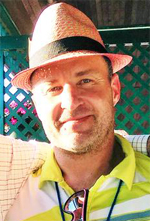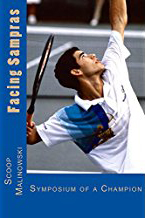Facing Sampras
Scoop Malinowski
Here are some fascinating excerpts from Scoop Malinowsski's new book on playing and practicing with Pete Sampras. (Click Here to Order.)

Matt Wilander
The first time I played Pete I actually thought there's absolutely zero chance he will make it. None.
I played him in 1989 and lost and I remember going to the press conference and everybody asked, so what do you think? I lost in five sets so I was slightly upset in a way.
But I said there's no way you can play tennis like that. You can't hit one in and one out. Even though we already had Boris Becker, Pete took that style of play to the next level. At 30-0 on my serve he would not put the ball in play, intentionally I believe. And the intention I realized later is so that I wouldn't get any rhythm.
So it's a very clever play. It's just ugly. It's just ugly. When you are playing against him it's just so ugly. He can't even hit the ball in the court.
The idea is to have a conversation. And Pete was the first guy to say, "Fuck you Matts. I am not worried about you.
"I am gonna hold serve and I'm going to try to keep the ball in play when it's zero-zero or fifteen all. Once you're up, you're not gonna get anything from me. Forget it."

And it worked. Because you feel like you get to 4 all and he hasn't literally hit a ball in the court. It's 4 all and I haven't really played. I haven't really played in his service games and I haven't really played in mine properly. Maybe a point or two.
Then Pete developed into an unbelievable player and we realized, that's just how he played. So never practice with Pete Sampras.
Don't practice with him. He doesn't keep the ball in play. For him it was: he thinks I'm absolutely nothing. Nice guy though. Nice guy. He's a great guy.
Andre Agassi
Pete senses the important times of a match and puts pressure on you. Then elevates his game.
So you can play for an hour and not even break a sweat sometimes because he's just taking the rhythm out of the match. He's playing quick points, getting in, missing a few. Then all of a sudden he plays a good game and he's off.
Paul Goldstein
My memory of Pete is just feeling like I've hurt him to the forehand side and just having him explode out there and just tomahawk a forehand on a ball I wasn't even sure he would get to. And then not only would he get there, he ropes the forehand.
Patrick Rafter
In a lot of ways, Pete was really ugly to play. When I played Pete it was just the ugliest match I've ever seen.
It's like Andre Agassi said in his book: He's not even there. He's serving bombs, then all of a sudden he hits four clean winners and he's won the set. That's exactly what Pete was like—bloody annoying.
Fred Viancos
I played against Pete and also another great server, Greg Rusedski. Their serve speeds were about the same. But against Rusedski I felt I could return.
Against Pete, that serve was so heavy, it was like trying to return a bowling ball with a badminton racket. (Click Here for an actual quantitative comparison between the speed, spin, and "weight" of the serves of these two great players.)
Fillip Dewulf
At the time he had a tendency to practice with a lot of lower level players. I don't know if it was for his confidence or whatever. I think he practiced a little bit like Roger Federer does now.
Loose and not so much pressure. Not like practice with Rafa where you will really have to work hard to keep up with him. With Pete it was pretty cool.
The only thing was after we hit some balls—I think it was an hour—I said "I would like to play some points." Just to get a bit more and I asked him to play a tiebreaker.
And he looked at me like "Are you sure?" And I lost 7-0. That's my memory of practicing with Pete Sampras.
John Yandell
I am always fascinated what great players can, or usually can't, articulate about technique. I have a couple of stories about things Pete said that illustrate that.
In a press conference I once asked him: "Pete you were hitting your forehand so well today—can you tell me one or two technical things?"
His response was: "I don't know it's just a natural feeling." Now that was so interesting because I knew from Robert Lansdorp the exact points Lansdorp had drilled into him. I even had video Lansdorp gave me video showing Pete at age 9 doing a drill to work on extension—the famous one where he made all his players "Hold it out front" so he could see how far through the shot the racket went. Obviously that went into Pete's subconscious and into his body but he couldn't articulate it verbally, and didn't need to.
Elliot Teltscher told me a similar story. When he was director of player development for the USTA Pete agreed to do a volley clinic for some elite juniors. Elliot gave him the big build up and turned to Pete and said something like, "So Pete teach us all how to volley."
Elliot said that Pete's face literally turned white and his response was something like, "I don't know how to volley." Now I know Pete learned how to volley from Southern California coach Larry Easley. (We have a great article on it called The Two Step Volley, Click Here.)
And obviously Pete was one of the great volleyers of all time. It was the same point—he had assimilated what he was taught at a subverbal level. Just another example of how playing great tennis is definitely not a verbal experience.





